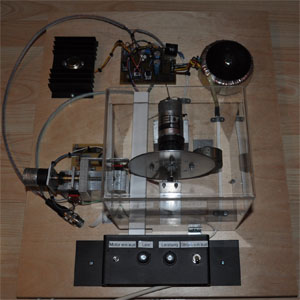2011 /2012
Constant speed control mit Simulationsprüfstand
Jahrgang
Projektpartner
Ingenieur Hermann Eigner
Maturanten

Brandstätter Kevin
5AAT

Eigner Andreas
5AAT
Betreuer
Schirz Walter
Nößlböck Josef
Problembeschreibung
Der Auftraggeber Herr Ingenieur Hermann Eigner hat uns gebeten für sein Eigenbauflugzeug PW235 einen sogenannten Constantspeedcontroller zu entwerfen. Dieser hat den Sinn, die Motordrehzahl des Flugzeuges bei sich ändernder Last am Verstellpropeller konstant zu halten um eine Leistungsoptimierung zu garantieren. Zurzeit kann man den am Flugzeug vorhandenen Propeller zwar verstellen, jedoch nur manuell über einen Kippschalter was nicht immer ein Optimum garantiert.
Zielsetzung
Ziel unserer Diplomarbeit war es den oben genannten Vorgang des Verstellens zu automatisieren und einen Regler zu entwerfen, welcher die tatsächliche Motordrehzahl auf eine vom Piloten ausgewählte Drehzahl hinregelt und diese konstant hält. Dabei war es wichtig auf folgende Punkte zu achten:
Der Regler musste in ein vorausgewähltes Gehäuse passen
Eine leichte Installation im Flugzeug muss gewährt werden
Die Regelabweichung darf maximal +/-50U/min betragen, damit die Leistungsoptimierung garantiert ist
Bei Ausfall des Reglers muss die Verstellung manuell erfolgen können
Um die Funktionalität überprüfen zu können wurde zusätzlich ein Simulationsprüfstand gefertigt.
Projektablauf
Entwurf verschiedener Konzepte für den Regler und den Prüfstand
Auswahl eines Konzepts und Anfertigung eines Terminplans
Entwurf eines Reglerprototypen
Entwurf und schematischer Aufbau des Simulationsprüfstandes
Nach erfolgreichen ersten Tests mit dem Regler wurde schlussendlich eine neue, verbesserte Version ausgearbeitet
Erfolgreiche Tests mit dem endgültigen Constantspeedcontroller
Anbringung im Gehäuse und Installation des Simulationsprüfstandes
Optimierung der Reglersoftware
Zusätzliche Anbringung eines Plexiglasschutzgehäuses am Prüfstand
Ergebnis
Der Constantspeedcontroller mit seinem zugehörigen Simulationsprüfstand wurden im April 2012 erfolgreich fertiggestellt und mehrmals zur Zufriedenheit des Auftraggebers getestet.
Systembeschreibung
Der Constantspeedcontroller kann ganz einfach durch eine fünf-polige Steckverbindung am Simulationsprüfstand oder im Flieger angebracht werden. Wenn der Motor läuft, wird sofort die aktuelle Drehzahl am Display des Reglers angezeigt. Anschließend ist es dem Benutzer möglich über einen Kippschalter den Verstellmodus auszuwählen – „AUT“ für Automatikbetrieb und „MAN“ für Manualbetrieb. Falls der Pilot im Manualbetrieb fliegen möchte, muss er die Steigung der Propellerblätter manuell über einen Kipphebel einstellen um auf die gewünschte Drehzahl zu kommen. Sollte er jedoch den Automatikbetrieb gewählt haben, so muss er nur noch die gewünschte Drehzahl auf dem kleinen Drehschalter auswählen und der Regler erledigt die restliche Arbeit für ihn. Um dem Benutzer die Maximalpositionen des Verstellpropellers zu signalisieren wurden zwei Leuchtdioden angebracht – leuchtet eine von beiden auf, so kann die Blattsteigung in diese Richtung nicht mehr verändert werden.
Presentation of the Problem
Mister engineer Hermann Eigner is the sponsor of our diploma project and he wanted us to build a so called constant speed controller for his plane PW235. Such a controller is necessary to keep the speed of the main motor constant if there are any load changes on the adjustable propeller and to guarantee a optimal tuning of the performance. At the moment it is already possible to adjust the propeller blades, but this can only be realized manual with the help of a small switch – this isn’t a perfect solution and it doesn’t guarantee the optimal performance in every flight mode.
Targets
The main target of our diploma project is to realize a constant speed controller, which adjusts the blades of the propeller fully automatic for different speeds, selected by the pilot. Before we were able to start with the detailed design, we had to think about how we could manage following things:
the controller has to fit in a pre selected box
the installation of the controller in a plane should be as easy as possible
to guarantee the optimal performance it is necessary that the speed of the engine isn’t faster or slower than the pre selected speed +/-50rpm
if an error occurs, the blades have to be adjustable manually
To test the functionality of our controller we have to construct a kind of equipment, which allows us to test every single component of our controller.
Order of Events
finding different concepts for our controller and the needed testing equipment
selection of the best fitting concept and thinking about a schedule
design of a controller prototype
design and first assembling of the testing equipment
first successful tests with the prototype / design of a final, corrected version
successful tests with the final controller
installation of the controller in the box and further assembling of the testing equipment
optimization of the controller software
installation of a glass case for more safety
Outcome
The constant speed controller with it’s accompanying testing equipment got finished in April 2012. After some final tests our sponsor mister Eigner was very satisfied with the results of our diploma project.
Description of the System
The controller can easily be connected with the plane or the testing equipment through a small plug connector. If the main engine of the testing equipment is turned on, the current speed of this engine is shown on a small display on the front side of the controller. Another thing is that there is the possibility to select between an automatic and a manual mode. If the pilot wants to adjust the blades of the propeller manually, he has to choose “MAN” for manual. Otherwise, if the blades should be adjusted automatically the pilot has to choose “AUT”. In this mode the controller is working for the pilot – means, the controller compares the speed with the pre selected speed and adjusts the blades of the propeller. To signal when the maximum positions of the propeller got reached, there are two LEDs on the front panel of the controller. If one of these two lights up, the propeller blades can’t be adjusted in this direction.


